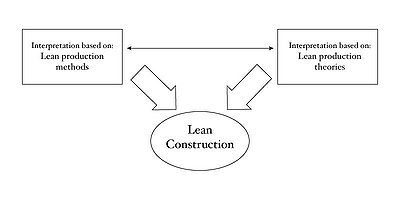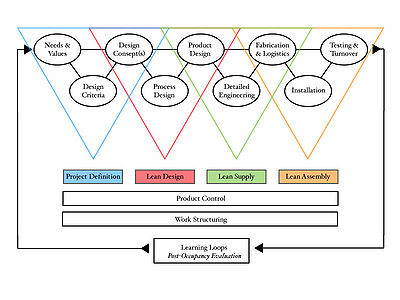Lean construction
(→Transformation, Flow and Value generation theory) |
(→What is Lean Construction?) |
||
| Line 27: | Line 27: | ||
These two interpretations is showed in two different definitions of lean construction. The first definition is from Koskela et al. (2002, p. 211): "Lean construction is a way to design production systems to minimize waste of materials, time, and effort in order to generate maximum possible amount of value." This definition shows that lean construction endeavors for the same goals as lean production which correspond to the first interpretation. On the other hand, The Lean Construction Institute defines lean construction as: "Lean Design and Construction is a production management-based approach to project delivery /.../ Lean Construction extends from the objectives of a lean production system - maximize value and minimize waste - to specific techniques, and applies them in a new project delivery process." This shows that LCI's definition correspond to the first interpretation. It has the same objectives as lean production and applies the techniques into construction. | These two interpretations is showed in two different definitions of lean construction. The first definition is from Koskela et al. (2002, p. 211): "Lean construction is a way to design production systems to minimize waste of materials, time, and effort in order to generate maximum possible amount of value." This definition shows that lean construction endeavors for the same goals as lean production which correspond to the first interpretation. On the other hand, The Lean Construction Institute defines lean construction as: "Lean Design and Construction is a production management-based approach to project delivery /.../ Lean Construction extends from the objectives of a lean production system - maximize value and minimize waste - to specific techniques, and applies them in a new project delivery process." This shows that LCI's definition correspond to the first interpretation. It has the same objectives as lean production and applies the techniques into construction. | ||
| − | = | + | =A New Theory of Production= |
Transformation, Flow and Value generation (TFV) model is a new theory of production. The model is the ground stone of lean construction and it is a conceptualization of three theories of production used in the twentieth century; Transformation, Flow and Value generation theories of production (Shao gao). Each of the three theories have introduced their own methods, tools and templates for production. The TFV model is based on the view that Transformation, Flow and Value generation are not competing alternative theories, but rather complement each other (Koskela 2002). | Transformation, Flow and Value generation (TFV) model is a new theory of production. The model is the ground stone of lean construction and it is a conceptualization of three theories of production used in the twentieth century; Transformation, Flow and Value generation theories of production (Shao gao). Each of the three theories have introduced their own methods, tools and templates for production. The TFV model is based on the view that Transformation, Flow and Value generation are not competing alternative theories, but rather complement each other (Koskela 2002). | ||
==Transformation theory of production== | ==Transformation theory of production== | ||
| − | + | The transformation view of production is the dominant view of production and has its roots in economics where | |
==Flow theory of production== | ==Flow theory of production== | ||
| Line 37: | Line 37: | ||
==Value generation theory of production== | ==Value generation theory of production== | ||
| + | ==Transformation, Flow and Value generation theory== | ||
| + | Table | ||
Revision as of 12:24, 20 November 2014
Construction industries are known for working in projects, and those projects are today complex, uncertain and quick CUQ-projects (Koskela, 2002). They are also known for having lower productivity and higher wastes than other industries (Forbes and Ahmed, 2011). Lean construction thinking started in the middle of 1990 as a way handle these CUQ-projects. Lean production is well known within manufacturing industries to increase productivity and reduce wastes, but the lean production thinking cannot directly be applied to the construction industry. The reason is that there is a list of factors that differentiates the construction industry from manufacturing industries, e.g. duration of projects, ((Shang and Low, 2014)).
There are two different interpretations of lean construction. (1) Lean Construction is about how Lean Production methods can be applied to construction, and (2) Lean Construction is a new, theory-based methodology for construction inspired of Lean Production (Koskela, 2002). The second theory is the most common interpretation and also mayor interpretation used within the International Group for Lean Construction.
Lean Construction is based on three views in production theory, Transformation, Flow and Value (TFV). These three views do not compete with each other but rather are complementary. All systems that pursue the TFV goals are in a way lean systems, but some are systems are better than others (Koskela, 2002).
Contents
|
Development history
The first signs of lean thinking in the construction industry goes back to the 1890s. Frank Gilbreth saw potentials in how to apply manufacturing approaches into construction in order to improve speed and labour efficiency. He saw opportunities in how to reduce what in lean thinking in called wastes. Gilbreth developed a body of knowledge that is considered to be a part of the body of knowledge that formed the field of industrial engineering (Modern Construction Lean Project Delivery and Integrated Practices p52).
The construction industry had a slower productivity growth than other industries in the twentieth century. Historically the industry had build on the Master Builder concept were one entity had responsibility for both design and construction. During the twentieth century the industry converted from Master Building concept to be more fragmented. Designers developed contracts that reduced their construction responsibility which led to more costly and counterproductive behaviors due to adversarial relations and mistrust. Studies from the 1990s and 2000s showed that hours spend productivity were very low and value-added time even lower, there is thus much room for improvement.
In the early 1990s Lauri Koskela looked, like Gilbreth did hundred years earlier, to the manufacturing industry for solutions and directions for the construction industry. Koskela specifically looked at Toyota's successful production system (TPS) and lean production and stated the most successful manufacture methods where based on the Just In Time (JIT) concept (Koskela 1992). Furthermore, Koskela introduced the Transformation, Flow and Value (TFV) theory which is derived from earlier theories regarding production (Koskela 2000).
Koskelas work is the foundation of lean construction, and resulted in a conference in Helsinki, Finland 1993 where the expression "Lean Construction" was decided to be used and the International Group for Lean Construction (IGLC) was founded. Subsequently Glenn Ballard and Greg Howell co-founded the Lean Construction Institute (LCI) in 1997. Studies performed by members from both IGLC and LCI led to Ballard's development of the The Last Planner System (LPS) and The Lean Project Delivery System (LPDS) (Modern Construction Lean Project Delivery and Integrated Practices p53-55).
- Adoption of Relational Contracting
- "Lean Design and Construction is particularly useful on complex, uncertain and quick projects" http://www.leanconstruction.org/about-us/what-is-lean-construction/
What is Lean Construction?
Lean construction is derived from the success of lean thinking within manufacturing industries. There are two slightly different main interpretations of lean construction. The first interpretation, as mentioned above, is about the application of lean production methods to construction. The second interpretation, on the other hand, views lean production as inspiration to the development of a new theory-based methodology for the construction industry (Koskela 2002).
These two interpretations is showed in two different definitions of lean construction. The first definition is from Koskela et al. (2002, p. 211): "Lean construction is a way to design production systems to minimize waste of materials, time, and effort in order to generate maximum possible amount of value." This definition shows that lean construction endeavors for the same goals as lean production which correspond to the first interpretation. On the other hand, The Lean Construction Institute defines lean construction as: "Lean Design and Construction is a production management-based approach to project delivery /.../ Lean Construction extends from the objectives of a lean production system - maximize value and minimize waste - to specific techniques, and applies them in a new project delivery process." This shows that LCI's definition correspond to the first interpretation. It has the same objectives as lean production and applies the techniques into construction.
A New Theory of Production
Transformation, Flow and Value generation (TFV) model is a new theory of production. The model is the ground stone of lean construction and it is a conceptualization of three theories of production used in the twentieth century; Transformation, Flow and Value generation theories of production (Shao gao). Each of the three theories have introduced their own methods, tools and templates for production. The TFV model is based on the view that Transformation, Flow and Value generation are not competing alternative theories, but rather complement each other (Koskela 2002).
Transformation theory of production
The transformation view of production is the dominant view of production and has its roots in economics where
Flow theory of production
Value generation theory of production
Transformation, Flow and Value generation theory
Table
TFV (The foundations of lean construction och Lean construction pdf)
Major concepts
- Different views on lean construction
Lean Project Delivery System
Last planner system
kanban cards
Target Value Design
- Kanban and production smoothing
The LPS was applied to the design process in 1998, representing another milestone. The design process was further improved with the application of target value design (TVD). The first TVD paper was published in 2004.
Key elements
BIM
Big Room
Related material
- Comparable standards / recommendations
- Additional related material
Discussion
Strength and weaknesses/criticism
- Controversial points
tabell i lean construction pdf, sidan 59
Integration / relationship to other material
- Sustainable development
Implementation advice
- How can it be implemented in construction industries

